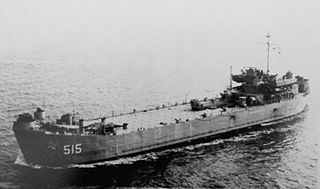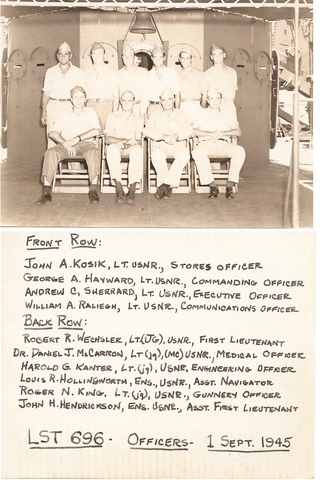
Exercise Tiger, or Operation Tiger, was one of a series of large-scale rehearsals for the D-Day invasion of Normandy, which took place in April 1944 on Slapton Sands in Devon. Coordination and communication problems resulted in friendly fire injuries during the exercise, and an Allied convoy positioning itself for the landing was attacked by E-boats of Nazi Germany's Kriegsmarine, resulting in the deaths of at least 749 American servicemen.

Landing Ship, Tank (LST), or tank landing ship, is the naval designation for ships first developed during World War II (1939–1945) to support amphibious operations by carrying tanks, vehicles, cargo, and landing troops directly onto a low slope beach with no docks or piers. The shallow draft and bow doors and ramps enabled amphibious assaults on almost any beach. The LST had a highly specialized design that enabled ocean crossings as well as shore groundings. The bow had a large door that could open, deploy a ramp and unload vehicles. The LST had a flat keel that allowed the ship to be beached and stay upright. The twin propellers and rudders had protection from grounding. The LSTs served across the globe during World War II including in the Pacific War and in the European theatre.
USS LST-991 was an LST-542-class tank landing ship in the United States Navy. Like many of her class, she was not named and is properly referred to by her hull designation.
USS LST-712 was a LST-542-class tank landing ship built for the United States Navy during World War II.
USS ''LST-84'' was one of the hundreds of Tank landing ships built during World War II to support amphibious military operations. Her role was to carry significant quantities of vehicles, cargo, and troops directly onto an unimproved shore. The ship was sponsored by Mrs. W. Raymond Brendel. The ship was constructed inland at Jeffersonville, Indiana, by the Jeffersonville Boat & Machine Co. as coastal ship yards were used to build larger naval vessels. The ship traversed the Ohio and Mississippi River to reach open water.

USS LST-519 was an LST-491-class tank landing ship built for the U.S. Navy in World War II. She was later renamed USS Calhoun County (LST-519) after counties in eleven states in the United States.
USS Armstrong County (LST-57) was an LST-1-class tank landing ship built for the United States Navy during World War II. Named for counties in Pennsylvania, South Dakota, and Texas, she was the only U.S. Naval vessel to bear the name.
USS LST/LST(H)-482/Branch County (LST-482) was an LST-1-class tank landing ship built for the United States Navy during World War II. Later renamed for Branch County, Michigan, she was the only US Naval vessel to bear the name.

USS Caddo Parish, originally named LST-515, was an LST-491-class tank landing ship built for the United States Navy during World War II. Like many of her class, she was not originally named and was properly referred to by her hull designation. On 1 July 1955, she was given the name Caddo Parish, named after Caddo Parish, Louisiana, she was the only U.S. Naval vessel to bear the name.

USS Cassia County (LST-527) was an LST-491-class tank landing ship built for the United States Navy during World War II. Named for Cassia County, Idaho, she was the only U.S. Naval vessel to bear the name. USS Cassia County is recognized for service in World War II during the Invasion of Normandy, and in the Korean War.

USS LST-472 was a United States Navy LST-1-class tank landing ship used in the Asiatic-Pacific Theater during World War II. As with many of her class, the ship was never named. Instead, she was referred to by her hull designation.

USS LST-480 was an LST-1-class tank landing ship built for the United States Navy used in the Asiatic-Pacific Theater during World War II.
USS LST-559 was a United States Navy LST-542-class tank landing ship in commission from 1944 to 1946.

USS LST-469 was a United States Navy LST-1-class tank landing ship used in the Asiatic-Pacific Theater during World War II. As with many of her class, the ship was never named. Instead, she was referred to by her hull designation.

USS LST-696 was an LST-542-class tank landing ship built for the United States Navy during World War II. LST-696 was laid down on 25 February 1944 at Jeffersonville, Indiana, by the Jeffersonville Boat & Machine Company; launched 25 April 1944; and commissioned 25 May 1944.
USS LST-713 was an LST-542-class tank landing ship built for the United States Navy during World War II.
USS LST-569 was a United States Navy LST-542-class tank landing ship used in the Asiatic-Pacific Theater during World War II.

USS LST-348 was a United States Navy LST-1-class tank landing ship that was built and deployed during World War II. The ship was constructed throughout late 1942 and early 1943 before being deployed to the European theater, where it undertook supply operations in support of Allied troops in North Africa and Italy. It was sunk by a German U-boat in February 1944.

USS LST-871 was an LST-542-class tank landing ship in the United States Navy. Like many of her class, she was not named and is properly referred to by her hull designation.
USS LST-80 was a LST-1-class tank landing ship in the Royal Navy during World War II.










